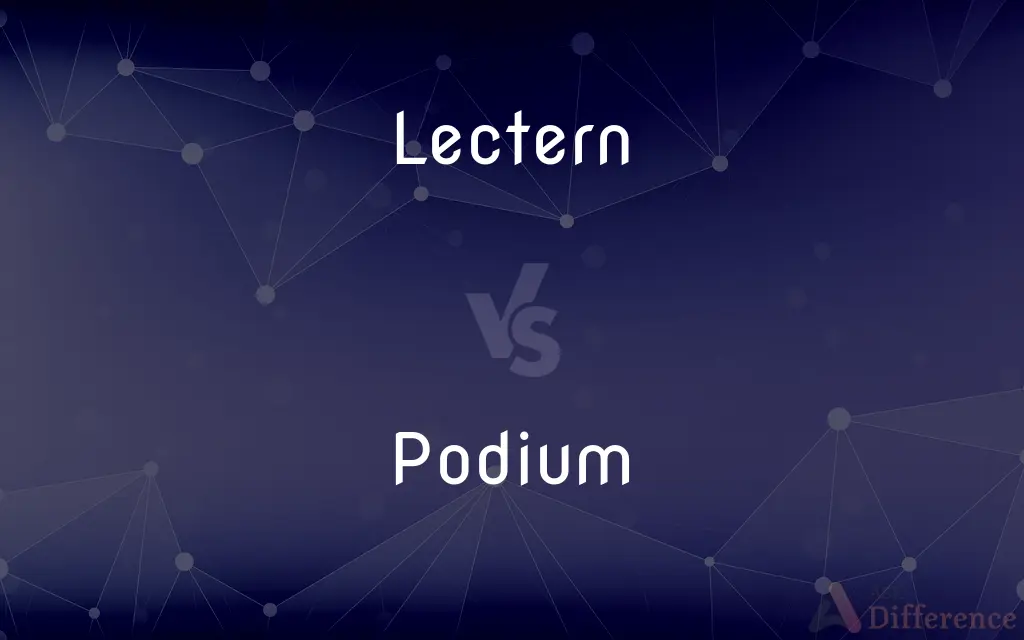Lectern vs. Podium — What's the Difference?
Edited by Tayyaba Rehman — By Maham Liaqat — Updated on March 16, 2024
A lectern is a stand for holding notes or books during a speech, focusing on the speaker's comfort, whereas a podium is a raised platform for speakers or performers, elevating them above the audience.

Difference Between Lectern and Podium
Table of Contents
ADVERTISEMENT
Key Differences
A lectern serves as a stand designed specifically for speakers to hold their notes, books, or electronic devices during a presentation or speech. It is often seen in conferences, churches, and events where a speaker needs support for their materials. Whereas, a podium is a raised platform that elevates speakers or performers above the audience, enhancing visibility and acoustic reach. Podiums are commonly used in various events, including concerts, award ceremonies, and sports events.
The primary function of a lectern is to provide a comfortable and practical space for the speaker to manage and refer to their presentation materials. It may be equipped with features such as adjustable height, built-in microphones, and light fixtures. On the other hand, the main purpose of a podium is to elevate individuals for better visibility and audibility, often emphasizing the significance of the speaker or performer's role.
Lecterns can be portable or fixed, made of wood, metal, or plastic, and designed to complement the aesthetics of the venue. They are often positioned on top of a podium or stage to combine the benefits of elevation with functionality. Conversely, podiums are typically constructed from sturdy materials like wood or metal and may include steps, railings, and sometimes space for multiple individuals.
In educational settings, lecterns are frequently used by lecturers or speakers to support their teaching materials, making it easier to engage with students. Whereas, podiums might be utilized in school assemblies, graduations, or sports events, serving as a central point of attention and authority.
Cultural and historical contexts often dictate the use of lecterns and podiums. For example, lecterns are symbolic in religious settings, used for reading sacred texts, while podiums are associated with power and leadership, reflected in political and ceremonial events.
ADVERTISEMENT
Comparison Chart
Primary Function
Holds notes/books for speakers.
Elevates people above an audience.
Usage Contexts
Conferences, churches, events.
Concerts, ceremonies, sports events.
Features
May include adjustable height, microphones.
Often has steps, railings, space for multiple individuals.
Material
Wood, metal, plastic.
Wood, metal, often sturdy construction.
Cultural Significance
Symbolic in religious contexts.
Associated with power, leadership.
Compare with Definitions
Lectern
Portable or fixed support.
The portable lectern was moved to the center of the stage.
Podium
May include space for several people.
The debate team gathered on the podium.
Lectern
Symbolic in certain contexts.
He read from the lectern. following the tradition.
Podium
A raised platform for visibility.
The conductor stood on the podium to lead the orchestra.
Lectern
A stand for holding presentation materials.
The speaker approached the lectern to begin her lecture.
Podium
Enhances speaker or performer's presence.
Winners stepped up to the podium to receive their medals.
Lectern
Often equipped with modern features.
This lectern has a built-in light and microphone for ease of speaking.
Podium
Reflects authority or honor.
Standing on the podium. she felt a sense of achievement.
Lectern
Used in a variety of venues.
The church's lectern is made of beautifully carved wood.
Podium
Constructed for durability and safety.
The podium was designed with railings for safety.
Lectern
A lectern (from the Latin lectus, past participle of legere, "to read") is a reading desk, with a slanted top, usually placed on a stand or affixed to some other form of support, on which documents or books are placed as support for reading aloud, as in a scripture reading, lecture, or sermon. To facilitate eye contact and improve posture when facing an audience, lecterns may have adjustable height and slant.
Podium
A podium (plural podiums or podia) is a platform used to raise something to a short distance above its surroundings. It derives from the Greek πόδι (foot).
Lectern
A tall stand with a sloping top to hold a book or notes, from which someone, typically a preacher or lecturer, can read while standing up.
Podium
An elevated platform, as for an orchestra conductor or public speaker.
Lectern
A reading desk with a slanted top used to hold a sacred text from which passages are read in a religious service.
Podium
A stand for holding the notes of a public speaker; a lectern.
Lectern
A stand that serves as a support for the notes or books of a speaker.
Podium
A low wall serving as a foundation.
Lectern
A stand with a slanted top used to support a bible from which passages are read during a church service.
Podium
A wall circling the arena of an ancient amphitheater.
Lectern
A similar stand to support a lecturer's notes.
Podium
(Biology) A structure resembling or functioning as a foot.
Lectern
A choir desk, or reading desk, in some churches, from which the lections, or Scripture lessons, are chanted or read.
Podium
To complete a competition, especially a race, as one of the top three contestants, usually being honored while standing on a podium.
Lectern
A reading desk, usually in the form of a stand with a slanted top that holds books or lecture notes at a height convenient for reading by a speaker who is standing. A modern lectern may be of adjustable height, and be fitted with a light to illuminate the material on the desk, and sometimes a microphone or other electrical equipment for use of a speaker.
Podium
A platform on which to stand, as when conducting an orchestra or preaching at a pulpit; any low platform or dais.
Lectern
Desk or stand with a slanted top used to hold a text at the proper height for a lecturer
Podium
(sometimes proscribed) A stand used to hold notes when speaking publicly.
Podium
A steepled platform upon which the three competitors with the best results may stand when being handed their medals or prize.
Podium
(sports) A result amongst the best three at a competition.
Podium
A low wall, serving as a foundation, a substructure, or a terrace wall.
Podium
The dwarf wall surrounding the arena of an amphitheatre, from the top of which the seats began.
Podium
The masonry under the stylobate of a temple, sometimes a mere foundation, sometimes containing chambers.
Podium
A foot or footstalk.
Podium
To finish in the top three at an event or competition.
The swimmer podiumed three times at the Olympics.
Podium
A low wall, serving as a foundation, a substructure, or a terrace wall.
Podium
The foot.
Podium
A platform raised above the surrounding level to give prominence to the person on it
Common Curiosities
Are lecterns only used in religious settings?
No, lecterns are used in various settings, including conferences and educational institutions.
What is the primary purpose of a lectern?
To hold notes, books, or devices for speakers during presentations.
What materials are podiums typically made from?
Podiums are often made from sturdy materials like wood or metal.
Can a lectern be used without a podium?
Yes, lecterns can be used on flat ground or atop a podium for added elevation.
How does a podium enhance a speaker's presence?
By elevating them above the audience for better visibility and audibility.
How do podiums contribute to an event's success?
By focusing attention and improving communication between speakers and the audience.
How does the use of a lectern affect a speaker's presentation?
It can enhance the presentation by organizing materials and supporting speaker comfort.
What symbolizes leadership, a lectern or a podium?
A podium, due to its association with elevation, power, and visibility.
How do lecterns and podiums differ in educational settings?
Lecterns support teaching materials, while podiums are used in assemblies or ceremonies for visibility.
Can anyone use a podium during an event?
Usage typically depends on the event's structure and the organizer's discretion.
Is it common for lecterns to have built-in technology?
Yes, modern lecterns often include features like microphones and lights.
Do podiums always include steps or railings?
While common, not all podiums have steps or railings; it depends on the design.
Are lecterns and podiums interchangeable in their use?
While they serve different primary functions, they can be used together for enhanced communication effectiveness.
Why might a speaker prefer a podium?
For the elevation and authority it conveys, improving their interaction with the audience.
Can podiums be portable?
Yes, some podiums are designed to be portable, although they may be less common than portable lecterns.
Share Your Discovery

Previous Comparison
Cooperation vs. Teamwork
Next Comparison
Cloudy vs. FogAuthor Spotlight
Written by
Maham LiaqatEdited by
Tayyaba RehmanTayyaba Rehman is a distinguished writer, currently serving as a primary contributor to askdifference.com. As a researcher in semantics and etymology, Tayyaba's passion for the complexity of languages and their distinctions has found a perfect home on the platform. Tayyaba delves into the intricacies of language, distinguishing between commonly confused words and phrases, thereby providing clarity for readers worldwide.
















































